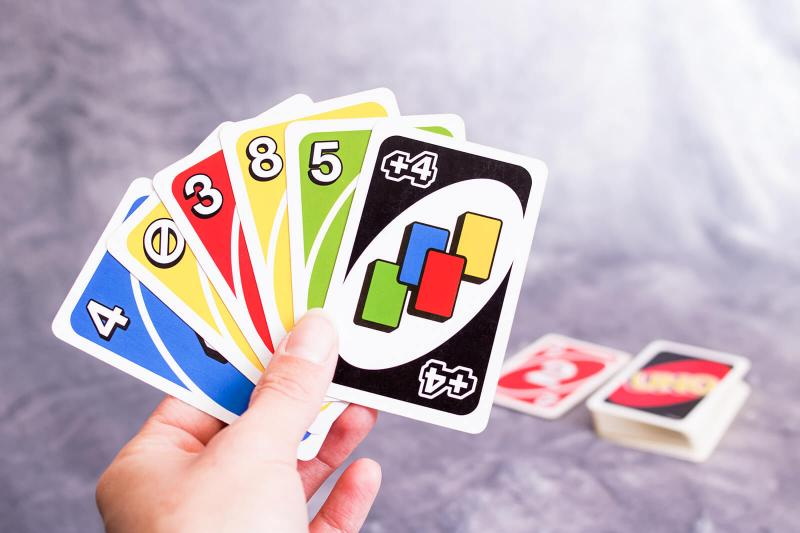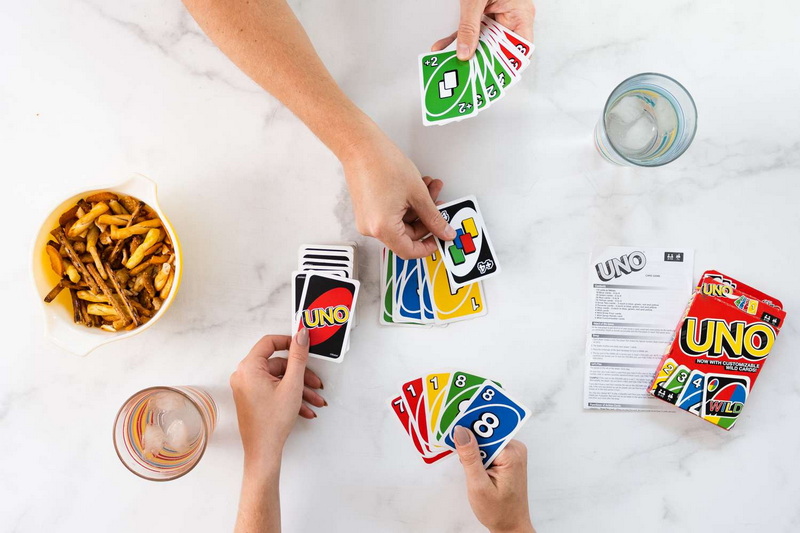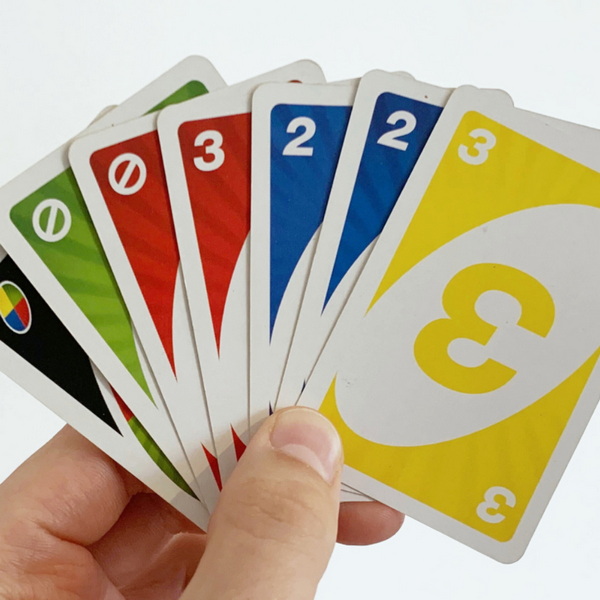Content Menu
● The Invention of Uno: A Journey Through History
● The Birth of Uno
>> Inspiration from Crazy Eights
>> The First Decks
● The Rise in Popularity
>> International Games Inc.
>> Global Expansion
● Cultural Impact
>> Innovations and Variations
● The Mechanics of Playing Uno
>> Basic Rules
>> Strategies for Winning
● The Digital Age of Uno
>> Mobile Applications
>> Social Media Influence
● The Legacy of Uno
>> Educational Benefits
● Conclusion
● Frequently Asked Questions
>> 1. Who invented Uno?
>> 2. What inspired Merle Robbins to create Uno?
>> 3. How did Uno become popular?
>> 4. When did Mattel acquire Uno?
>> 5. What are some popular variations of Uno?
● Citations:
The Invention of Uno: A Journey Through History
Uno is more than just a card game; it's a cultural phenomenon that has brought families and friends together for decades. The origins of Uno trace back to the early 1970s, when a barber named Merle Robbins created it in Reading, Ohio. This article explores the story behind Uno's invention, its evolution, and its impact on popular culture.

The Birth of Uno
In 1971, Merle Robbins found himself in a friendly dispute with his son Ray over the rules of a traditional card game known as Crazy Eights. The complexities and variations of Crazy Eights often led to confusion and arguments among family members. To resolve this issue, Robbins decided to create a new game that would simplify the rules and provide a more enjoyable experience for everyone involved.
Inspiration from Crazy Eights
Robbins drew inspiration from Crazy Eights, which is played with two decks of cards. In Crazy Eights, players take turns discarding cards that match the rank or suit of the top card on the discard pile. However, the various house rules often led to disagreements. To create a more straightforward game, Robbins designed a deck of cards with specific rules for each card type:
- Kings would reverse the direction of play.
- Queens would allow players to skip their next turn.
- Aces were designated as wild cards.
This innovative approach not only made the game easier to understand but also added an element of strategy that was missing from Crazy Eights.
The First Decks
To bring his vision to life, Robbins and his family mortgaged their home to raise $8,000. They printed 5,000 decks of Uno at a local printing company. The original decks were crafted on their dining room table, showcasing vibrant colors and unique designs that set them apart from traditional playing cards.
Robbins initially sold Uno from his barbershop in Reading, Ohio. He also promoted the game by demonstrating it at local campgrounds and community gatherings. As word spread about this new card game, demand began to grow.
The Rise in Popularity
International Games Inc.
In 1972, after experiencing success with initial sales, Robbins sold the rights to Uno for $50,000 plus royalties of ten cents per deck to Robert Tezak, who owned a funeral parlor in Joliet, Illinois. Tezak formed International Games Inc., which played a crucial role in marketing and distributing Uno on a larger scale.
Under Tezak's leadership, the game underwent significant redesigns and rebranding efforts. The packaging was changed from its original green color to the iconic red that we recognize today. This new branding helped establish Uno as a household name.
Global Expansion
Throughout the 1980s and beyond, Uno's popularity soared. It became one of the best-selling card games in America and eventually gained international acclaim. By 1992, Uno had sold over 100 million copies worldwide. Its appeal transcended age barriers; children could play alongside adults without feeling overwhelmed or bored.
In 1992, Mattel acquired International Games Inc., further solidifying Uno's place in toy history. Mattel's extensive distribution network allowed Uno to reach an even wider audience, making it available in over 80 countries.
Cultural Impact
Uno has left an indelible mark on popular culture since its inception. It has been featured in various films, television shows, and even video games. Its distinctive gameplay mechanics have inspired numerous variations and themed editions that cater to different audiences.
Innovations and Variations
Over the years, Uno has evolved significantly. New versions have been introduced to keep up with changing consumer preferences:
- Uno Attack: A version featuring an electronic card shooter.
- Uno Flip: A twist on the original game with double-sided cards.
- Special Editions: Collaborations with franchises like Disney and NFL have resulted in themed decks that appeal to fans of all ages.
These innovations have ensured that Uno remains relevant in an ever-changing gaming landscape.

The Mechanics of Playing Uno
Uno's gameplay is straightforward yet engaging. Each player is dealt seven cards from a specially designed deck consisting of colored number cards (red, yellow, green, and blue) as well as action cards like Skip, Reverse, Draw Two, Wild, and Wild Draw Four. The objective is simple: be the first player to get rid of all your cards.
Basic Rules
1. Starting Play: The top card from the draw pile is flipped over to start the discard pile.
2. Matching Cards: Players take turns matching a card from their hand with either the color or number of the top card on the discard pile.
3. Action Cards: If an action card is played (e.g., Skip), its effect is applied immediately.
4. Drawing Cards: If a player cannot play any card from their hand, they must draw one card from the draw pile.
5. Calling “Uno!”: When a player has only one card left in their hand, they must call out “Uno!” Failure to do so results in drawing two penalty cards if caught before their next turn.
6. Winning: The first player to empty their hand wins that round; points are calculated based on cards remaining in opponents' hands.
Strategies for Winning
While Uno is largely based on luck due to its random draw mechanics, strategic thinking can enhance your chances of winning:
- Card Management: Keep track of which colors are being played frequently and adjust your strategy accordingly.
- Action Cards Usage: Use action cards wisely; holding onto them until they can create maximum disruption for opponents can turn the tide.
- Anticipate Opponents' Moves: Pay attention to what cards your opponents are playing; this can give clues about what they might have left in their hands.
The Digital Age of Uno
With technological advancements transforming how we engage with games, Uno has successfully transitioned into digital formats. Players can enjoy Uno on various platforms including smartphones, tablets, gaming consoles like PlayStation and Xbox, as well as through online multiplayer modes.
Mobile Applications
Uno's mobile app allows players to connect with friends or engage with random opponents online while retaining classic gameplay elements alongside new features such as customizable house rules and themed events.
Social Media Influence
Social media has played a significant role in reviving interest in Uno among younger audiences. Memes about gameplay moments—especially those involving strategic plays or humorous penalties—have circulated widely across platforms like Twitter and Instagram.
The Legacy of Uno
Uno's legacy extends beyond mere entertainment; it serves as a tool for social interaction and bonding among families and friends alike. The game's simplicity makes it accessible for players of all ages—from young children learning basic counting skills to adults engaging in friendly competition during gatherings.
Educational Benefits
Playing Uno can enhance several skills:
- Mathematical Skills: Players practice counting points at the end of each round.
- Strategic Thinking: Deciding which card to play involves critical thinking about potential outcomes based on opponents' visible cards.
- Communication Skills: Engaging with others during gameplay fosters conversation and camaraderie.
Conclusion
The story of Uno is one of creativity, perseverance, and family bonding. From its humble beginnings as a solution to family disputes over Crazy Eights to becoming one of the best-selling card games globally, Uno has captured hearts across generations. Its simple yet engaging gameplay continues to foster connections among players around the world.
As we look forward to future iterations and adaptations of this beloved game, it's clear that Uno will remain a staple in homes for years to come—providing laughter and competition for families and friends alike.

Frequently Asked Questions
1. Who invented Uno?
Uno was invented by Merle Robbins in 1971 as a way to simplify the rules of Crazy Eights for his family.
2. What inspired Merle Robbins to create Uno?
Robbins was inspired by frequent arguments over the rules of Crazy Eights within his family and sought to create a simpler game.
3. How did Uno become popular?
After selling the rights to Robert Tezak at International Games Inc., aggressive marketing strategies helped propel Uno into mainstream success during the 1980s.
4. When did Mattel acquire Uno?
Mattel acquired International Games Inc., along with Uno's rights, in 1992.
5. What are some popular variations of Uno?
Some popular variations include Uno Attack, Uno Flip, and themed editions based on franchises like Disney and NFL.
Citations:
[1] https://www.reddit.com/r/AskHistorians/comments/15640ga/what_is_the_history_of_check_uno_and_related_card/
[2] https://www.cnn.com/2024/06/03/business/uno-card-game-popularity-cec/index.html
[3] https://www.unovariations.com/every-type-of-uno-card-game-and-spinoff
[4] https://fastercapital.com/content/Uno--The-Classic-Card-Game-for-Family-Fun-and-Friendly-Competition.html
[5] https://www.unovariations.com/posts/history-of-uno
[6] https://uproxx.com/life/new-uno-rules/
[7] https://www.antsylabs.com/blogs/the-ant-hill/uno-challenge-2023-17-uno-variations-you-need-to-try-this-year
[8] https://learningcorner.co/activity/139114
[9] https://www.backthenhistory.com/articles/the-history-of-uno
[10] https://www.lovetoknow.com/life/lifestyle/uno-rules
[11] https://www.unovariations.com
[12] https://trinityecho.com/35336/features/the-dominant-reign-of-the-king-of-uno/
[13] https://www.unorules.org/uno-history/
[14] https://upload.wikimedia.org/wikipedia/commons/thumb/7/72/Uno_Old_Deck.jpg/220px-Uno_Old_Deck.jpg?sa=X&ved=2ahUKEwizi-n_y_KKAxUNSjABHfjIBt0Q_B16BAgKEAI
[15] https://letsquitteaching.com/embracing-the-cards-were-dealt-lessons-from-uno/
[16] https://en.wikipedia.org/wiki/Uno_(card_game)
[17] https://www.youtube.com/playlist?list=PLwBXG1jii8ie9QDzdegriFjw_9LNjuhvN
[18] https://en.wikipedia.org/wiki/Merle_Robbins
[19] https://www.thegamer.com/best-uno-editions/
[20] https://worldsofwordcraft.wordpress.com/2023/04/09/reflections-on-uno-the-intersection-of-games-and-grief/
































